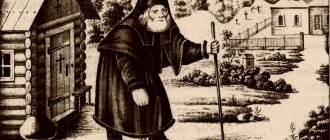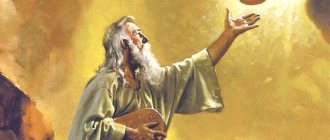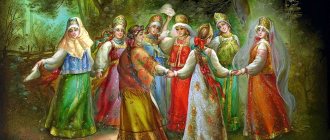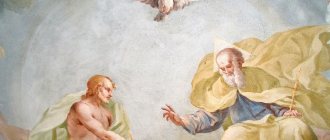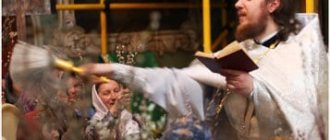What is hesychasm?
The term comes from the Greek word “hesychia”, the meaning of which is calm, silence and solitude. Hesychasm is a practice of monks in the Orthodox faith based on the teachings of Jesus. Its main goal is to contemplate the Divine light that will emanate from the heart. Mention of this practice was found in documents of the 3rd-4th centuries. n. e. It became most widespread thanks to Gregory Palamas in the 14th century. Hesychasm received official recognition in 1351.
According to this mystic practice, the Lord cannot be known through logical thinking or scientific knowledge. To see it, you need volitional efforts, you need to be focused and receive the condescension of God's grace. Three directions of hesychasm can be distinguished:
- hermitage - appeared in the first centuries of monasticism;
- spiritual practices that involve repeating Jesus' prayer;
- the teaching of Gregory Palamas on uncreated energies.
Hesychasm in philosophy
The basis of the practice is spiritual reincarnation, which gives a chance to communicate and see the Lord. Hesychasm in philosophy is an opportunity to understand that man is a microcosm in which the entire Universe is reflected. People who commit sins darken the image of the Lord in themselves, but if you live according to the commandments, you can cleanse your soul and get closer to the Higher powers through prayers. God constantly reveals himself to the world in his actions, such as power, love, wisdom, and so on.
Hesychasm in Orthodoxy
Practices can be divided into several elements, which must be performed exclusively in strict sequence.
- Cleansing the heart
. Christian hesychasm is based on the fact that only a person with a pure heart can see God. It is believed that people should be more ascetic in food, clothing and other areas. It is important to distract yourself from any objects of sensory pleasure, which will allow you to concentrate on communicating with the Lord. You can use mental-heart prayers, the constant pronunciation of which Jesus himself attached. - Solitude
. You need to practice only alone and preferably in the dark. This is important for maximum concentration. - Connecting mind and heart
. Orthodox hesychasm involves the use of meditation and breathing exercises. As a result, the mind is concentrated in the region of the heart, where the soul is located. This is commonly called “smart doing.” - Prayer
. The Jesus Prayer must be repeated continuously and in one breath. This is a special art that can be learned. - Silence
. After all the stages have been completed, there is a concentration on the heart and the formation of silence, which is important for communication with the Lord. - The appearance of the Tabor Light
. The last stage indicates entry into communion with God.
Optina Pustyn Monastery, Russia
One of the centers, along with Valaam and the Sarov Monastery, of the Russian hesychast revival. This revival is associated with the prayers and asceticism of St. Paisius Velichkovsky, who translated and distributed the Russian Philokalia, a collection of spiritual works related mainly to hesychasm. Modern hesychasts - Iliy Optinsky (born 1932 - in the photo), confessor of the monastery brethren.
Sergei Khoruzhy: “From the standpoint of Orthodox doctrine, the experience of hesychast asceticism is the experience of striving towards Christ and uniting with Him in His energies, in the Holy Spirit; and in turn, such experience is considered as the quintessence of authentically Christian experience, life in the Christian faith. In acquiring this experience is the goal and purpose of Christian life, and not only for hesychast ascetics, but for all Christians, even if they do not gain experience in full, but only to a certain extent, each individual, “as much as it can accommodate.” It is precisely because of this quintessentiality of the hesychast experience, which distinguishes it in all the diversity of religious experience, that hesychasm acquires a pivotal role in the world of Orthodox spirituality and churchliness.”
Modern hesychasm
In the world you can find several modern centers of hesychasm, and these include the following examples:
- Autonomous monastic state on Mount Athos, Greece
. Prayer books in the twentieth century revived hesychasm and gave it new impetus. There are several desert cells on the Holy Mountain, where monks who practice the theology of hesychasm live. - Hermitages, Moldova
. In the monasteries located in this country, there are people who practice hesychasm. - Monastery of John the Baptist, UK
. Hesychasm is also promoted for contemporaries in England. The practice was spread by the disciple of St. Silouan.
Sihastria Monastery, Romania
A small forest monastery where the hesychast tradition was continued and supported, including under the communists. Romanian hesychasts traditionally these days live in hermitages in the forest. The monastery contains the graves of famous hesychasts of our time - Cleopas Elijah and Paisius Olaru. The monastery has a museum of Cleopas Elijah (pictured below)
Sergei Khoruzhy, director of the Institute of Synergetic Anthropology: “In recent history there is a very striking, if you will, standard example of national hesychasm. This is what developed in the 70s. last century, a hybrid of Romanian hesychasm with “protochronism,” the ideology of the national communist regime of Ceausescu. Here hesychasm was put at the service of nationalism in the most frankly straightforward manner. The activities of the hesychast Romanian-Slavic community in the 18th century, created and headed by Rev. Paisiy Velichkovsky, was presented as proof of the primacy and superiority of Romanian spirituality and culture. The significance of this activity and its fruits have become hypertrophied to the point of absurdity. The same fact that Elder Paisius himself was not a Romanian was successfully overcome even in two ways: firstly, a theory was put forward about his Romanian origin (from adultery allegedly committed by his mother with a Romanian emigrant!); and secondly, the largest hesychast theologian Fr. Dumitru Staniloae, in his study “Hesychasm in the Romanian Orthodox Tradition,” instructed that it is necessary “to show not only what Paisius contributed to Romanian monasticism, but also what he received from it.”
Hesychasm - books
There are several literary works that expound the basic ideas and philosophy of hesychasm. Among the most popular books are the following:
- “Triads in Defense of the Sacred-Silent” G. Palamas
. The author defends and systematizes hesychasm and other teachings aimed at uniting man with God. - “One night in the desert of the Holy Mountain” Hierotheus (Vlahos)
. This book describes that hesychasm is a spiritual path and reveals the meaning of the Jesus Prayer, the stages of its training and possible results.
About the Venerable Joseph the Hesychast, the temple dedicated to him and mental prayer
July 23 this year In Tbilisi, a small but spiritually very significant temple was consecrated in the name of St. Joseph the Hesychast, the great prayer book and ascetic of the 20th century.
At the moment, there is more than one church of St. Joseph in the world, but they were all erected at monasteries, and mostly monastics pray in them. Tbilisi is essentially the first parish church in honor of the saint, built primarily for the spiritual needs of the laity. It is located at the Church of the Exaltation of the Cross, where the famous Georgian priest and preacher Archpriest Theodore Gignadze serves. This is the third temple built in this temple complex; a lively liturgical life takes place here: among the regular parishioners you can see people both young and elderly, and the former even far outnumber the latter; Among the regular parishioners there are no fewer men than women. All this can be explained by the special mood that reigns in this community, the focus on establishing a living, personal relationship with God through the Jesus Prayer and the Eucharist.
The dedication of the temple, intended for the laity, to St. Joseph the Hesychast, this famous practitioner of the Jesus Prayer, is in itself symbolic. It is no coincidence that the entrance to this small island of Athonite hesychasm in the modern metropolis is decorated with an inscription calling to prayer: “Lord Jesus Christ, Son of God, have mercy on me.” The holy fathers, including St. Joseph, and many contemporary confessors, including the rector of this church, Father Theodore, call in their writings to pray regularly, or even constantly, especially with this prayer.
Apparently, such a dedication is in line with the general focus of Father Theodore and his spiritual children on the practice of the Jesus Prayer, however, undoubtedly, the priest himself can best tell about this, so we give the floor directly to him.
Venerable Joseph the Hesychast
An example of persistent burning of spirit
– Father Theodore, what makes St. Joseph the Hesychast stand out? What significance does this saint have in the spiritual life of all Orthodox Christians (and not just Greeks)?
– Saint Joseph the Hesychast labored at a time when a certain crisis was noticeable in spiritual life. We mean the intensity of the Eucharistic life and hesychast practice - not only in monastic, but also in lay circles. If we look at the holy ascetics of the 20th century, whether on Mount Athos or in Greece, we see a kind of rise, at least from our position we see it that way, a rise in spiritual life. We see a multitude, a galaxy of saints whose canonization is still ongoing in the Greek world. Many of them are worthy of close attention. In particular, one of my favorite saints is Silouan of Athos. Then the canonization of his spiritual child, Archimandrite Sophrony (Sakharov), took place. Also Father Paisiy and many others...
Many of them are outstanding ascetics, but still Saint Joseph stands out among them for his, so to speak, productivity. I often say that he is the most productive saint of the 20th century in terms of his fruits. And by fruit I mean a quantitative indicator too. There are now many centers of spiritual life that are a continuation of his school. There are representatives of his school not only in Greece, but also abroad: on Athos, Cyprus, even in America. At this stage, the following monasteries were founded by the brotherhood of St. Joseph and the students of his theological school: on the holy Mount Athos - 6 monasteries, the monastery of St. Anna and many separate cells; in the rest of Greece - 18 monasteries; in Cyprus – 6; in the USA – 16; in Canada - 2 and in Italy - 1. About 1000 monks work in these monasteries, and their number continues to grow. In addition, there are parish churches that are the successors to the school of St. Joseph in the world. We believe that the number indicated here will further increase.
One more thing that should be said, which we ourselves heard in the Greek world, including in Cyprus: Saint Joseph the Hesychast is called the modern Gregory Palamas, since he revived hesychasm, including among the laity, and the modern Nicodemus the Holy Mountain, so how he, like him before, contributed to the revival of the Eucharistic life - I mean an intense Eucharistic life. After all, it was Saint Nicodemus in the 18th century who called for frequent communion.
Saint Joseph also had such an interesting personal trait, which, of course, is characteristic of every saint, but when reading his life this is especially visible and highlighted, and Bishop Athanasius, Metropolitan of Limassol, especially emphasizes this: the burning of the spirit with which Saint Joseph enters the Holy Mountain, he retains it until the end of his earthly life. That is, the elder was a steadfast warrior who never retreated back.
What do modern Christians need most today? - Burning of spirit!
And what do we, modern Christians, every Orthodox believer need most of all today? The intensity of the Eucharistic life, the revival of hesychast practice in our soul, no matter what our status in the Church, even if we are laymen. Burning of the spirit, without which there is no Christianity - after all, the Apostle Paul calls us to this (see: Rom. 12: 11). A striking example of the persistent burning of the spirit is precisely Saint Joseph the Hesychast.
– What moments of his life are especially worthy of imitation by modern Christians?
– It’s very interesting, for example, his attitude towards compliance with the charter. It is known what the charter of that small brotherhood was, led by Saint Joseph the Hesychast. These are night vigils - I mean the smart Jesus prayer. In fact, most of their life took place at night. They labored during the day in order to engage in an intense search for God at night. And they did everything for this and in no case violated this charter.
You remember, this is a well-known fact: they had financial difficulties because they were not within the walls of a large monastery, and fish were donated to them. However, its processing was associated with the abolition of night prayer, or at least part of it, that is, it was necessary to violate the charter. If they had prepared for the night service as they should, as required by their charter, the fish would have spoiled. So, from the life of St. Joseph, we know that the fish did spoil, and the night service took place as usual. This is a principled approach to getting up at night to pray.
This is the tradition of all saints, especially the Athonite fathers, who pray at night. But Saint Joseph showed this especially emphatically. This also exists in our small practice, the practice of our community: since its members, the laity, including those with families, love this saint, they also fell in love with getting up at night to pray. And if they don’t have some special job where this is absolutely impossible, many of them manage to do this - pray smart prayer at night. And these people accumulate personal and very interesting experience of spiritual life.
Temple conducive to hesychast prayer
– How many people know this saint in Georgia? Why did you decide to build the Church of St. Joseph in Tbilisi? Is this related to the practice of the Jesus Prayer to which St. Joseph calls us?
– I wouldn’t say that many people know Father Joseph. Although recently we have more or less begun to get acquainted with this saint. The book of Father Ephraim, one of his spiritual children, was also translated into Georgian. The instructions to the monks of Father Joseph himself had long been translated, although they had not yet enjoyed particular popularity, people were not familiar with it, and moreover, only a small part of them had been translated. But now this saint is becoming known to many.
We, our community, consider the fact that we built this temple to be a special grace of God; In general, we consider it a special mercy that we have a connection with this saint and with his spiritual school. For us, the construction of the temple became a direct sign from God, although it was not particularly easy and was accompanied by certain difficulties. But thank God that this temple was still built.
It turned out to be very neat, beautiful, similar to the ancient temples that were built in Georgia in the 6th century, according to ancient tradition, entirely made of stone, with very beautiful, from our point of view (Smiles.), icons inside and mosaics. The church is small, but very neat, it corresponds to Father Joseph and his small brethren. It resembles a small cave, so to speak, and this predisposes those entering to hesychast prayer.
Mental prayer is a step we take towards Christ. But we need to always look for Him, try to be with Him
And, of course, the idea of building such a temple lies precisely in this: in the popularization of this saint and, accordingly, in the popularization of hesychast mental prayer and intense Eucharistic life, without which, as we believe, Christianity is impossible. Because Christianity is Christ, and Christ dwells in our hearts, as He established, through the Eucharistic life (see: John 6:56). And mental prayer is a seeking step we take towards Him. We need to always seek Him, try to be with Him.
And the construction of this temple sets the task of emphasizing precisely this way of life. I repeat again: Father Joseph, already the Reverend Father Joseph, also called the laity to this prayer. So I think this temple will encourage many to learn – and this is exactly what they need to learn – mental prayer.
Our teachers and their lessons
Elder Ephraim of Arizona (Moraitis) - Do you personally know the disciples of St. Joseph - Father Ephraim of Arizona and others - or the disciples of his disciples? If yes, then tell us about them, please.
– We had the good fortune to meet the spiritual child of Father Joseph, whom we found - Father Ephraim of Philotheus (Arizona). A popular documentary film was made about him, a lot is written about him, and his books have also been published in both Georgian and Russian. In general, as the Lord teaches us, “a tree is known by its fruit” (Matthew 12:33; Luke 6:44) - and look, what is the fruit of Father Joseph!
It is very difficult to establish monasteries of the type in America that Father Ephraim created. His missionary work was very unconventional: he did not know English; As a rule, he missionized verbally to a lesser extent; the main tool of his missionary work was internal prayer.
And the fact is obvious. The monasteries he created are simply amazing, especially the monastery he built in Arizona. The monks there are filled with joy, constantly praying and taking communion. The missionary work of these monasteries, like the missionary work of Father Ephraim, stems from the way of life.
Truly the candle lit on the table and the city built on the top of the mountain were Father Ephraim and his brethren in America and truly an example of how missionary work should be done. And there is nothing new in this: the Lord teaches us to be the light of this world, and our light should shine so that, seeing it, other people also begin to seek God (see: Matt. 5: 14-16). That candle that burns in our heart from the Christian faith must, as the Apostle Peter says, turn into the sun, into the dawn (see: 2 Pet. 1:19). And Father Ephraim was the kind of person who in his heart turned that candle that burns in the heart of every Christian into the sun. And he turned it into precisely that practice, devoted adherence to the school that Father Joseph founded. And in his life we read how it was. This is what Father Ephraim says, for example: “The purpose of our life, its meaning was in the Jesus Prayer, we breathed it.” They lived it, that's the point! In addition, they had an intense Eucharistic life - and the result is obvious.
Father Ephraim said: “We breathed the Jesus Prayer.” They lived it, that's the point! - And the result is obvious
What else can I say? Those who read Father Ephraim’s book “My Life with Elder Joseph” probably remember what a sense of humor he had. And he maintained this humor until the end of his life. And when we met with him, it was still felt. Although the old man was already in deep weakness, he had this simple humor caused by happiness, a happiness that he constantly carried within himself.
At the same time, some kind of strength was felt in him: when he passed somewhere, there was a desire to press against the wall. But he had a small body, one might say that he was fragile, like a sparrow, but he had great inner strength. Yes, someone may say that this is a purely psychological moment based on his authority, but still everyone noted that he was endowed with some amazing inner strength.
Monastery of St. Anthony the Great in the Arizona desert
You know, even if there is a psychological element here, you can’t escape the facts. A man comes to America and, in a not so long period of time, founds as many as 18 monasteries! What is it like to found at least one such monastery, especially in a country where Orthodoxy is far from the main religion? Even using the example of Georgia, I can say that it is quite difficult to do - to found monasteries of this type. Therefore, the feeling in Elder Ephraim of this force cannot be considered a purely subjective moment - it was a reflection of objective reality. This is our opinion.
As for the other disciples, thank God, we have communication with Father Paisios (Papaioanu), abbot of the monastery in Arizona; also with the rector of Vatopedi, Father Ephraim, from whom we learned a lot; also with Bishop Athanasius, Metropolitan of Limassol, from whom we learn many things.
What can you say about them? I will emphasize: I want to talk about the Liturgy performed by these people and the clergy trained by them. We know, we have all read how Saint John of Kronstadt served the Liturgy. The way he served, no one served like that, his contemporaries remember. Unfortunately, today we cannot see or hear how this great saint, one of my most beloved saints, served. But still the conclusion suggests itself that the service can be held more majestic or less majestic.
What characterizes this school is the way in which worship is performed. How is it shown? Not in form, of course, but in something internal, in some nuances that are difficult to convey in words. This is extreme reverence for the altar, this is extreme freedom combined with reverence, but not in forms, of course. I mean inner freedom.
This is both extreme reverence for the altar and freedom combined with reverence - I mean inner freedom
The amazing intonation of the voice, which is not artificial, but absolutely natural and comes from the heart, and this indicates the hesychast state of the ministers, the existence of hesychast practice among them. Ideally, the Liturgy is the crown of hesychast practice, and it should be so.
If a person does not have the experience of going deeper into himself, of searching for God within himself, then the Liturgy he performs will naturally be of a more external nature and it will help less people who are called to participate in the Eucharistic service. In the service of those whom I have listed, and in the service of their pupils, this is precisely what is implied: service performed with an inner hesychast mental attitude. That's how I perceive it.
We learned a lot from them. I repeat once again: this learning is not just verbal: write something down, someone told you something. You need to touch it, it is transmitted through touch. I told you about Father Ephraim that he had amazing inner strength, and you could feel it. Communication with such people once again confirms the truth that the principle of succession in spiritual life - from mentor to spiritual child - is extremely important. Because there is a lot that you simply cannot read from a book. No matter how it is written, it cannot be perceived. Much is perceived simply by touch: you need to come, see, touch and experience. Therefore, I always advise those who ask, especially those who wish to serve in monasticism or the priesthood in the future, who study in theological educational institutions, that they must have a certain connection with representatives of this school. It is very important.
Hesychasm is a way of Orthodox life
– Which of the spiritual heritage or teachings of St. Joseph is most important for modern Christians?
– From the spiritual heritage of Father Joseph, as I have already said, the ability to fight, the fact that he did not like to retreat, loyalty to his principles, which are textbook for the life of a Christian, without which Christianity does not exist, are worthy of special attention. This is the Eucharistic life. In particular, he received from Saint Daniel the Hesychast that it is desirable to serve the Liturgy of the Presanctified Gifts every weekday during Lent. And we, thank God, have adopted this practice: in our church this Liturgy is served during Lent not only on Wednesdays and Fridays, but every weekday. And this turned out to be very important for our parishioners: practice has shown that the more often a person receives communion, the more he develops spiritually.
Do not retreat back in spiritual life! If you decide to start the Jesus Prayer, you need to choose some time from 24 hours. Aerobatics - getting up for prayer at night; if this does not work out - at dawn, or in the evening, or during the day - only this must be done with those nuances that St. Joseph taught us - sitting in the dark, etc., this is very important. This, of course, requires a mentor and guidance, but such mentors exist, thank God. And don’t retreat back, don’t give up. It’s better to do a little every day than a lot once a week. Therefore, systematicity is very important.
Do not retreat back, do not abandon the Jesus Prayer! Better every day a little than once a week a lot
And, of course, the amazing humility of Father Joseph, his vision of his unworthiness. Saint Joseph says about himself that he achieved nothing and did not bear any fruit at all[1]. And, seeing this, he tried every day to make the beginning of a spiritual life, because he categorically did not like the previous life and he believed that he had done nothing and had not even made the beginning of repentance as it should. “Every day I was put to shame again, because although I wanted to, I again could not make a beginning” [2] - amazing humility, without which holiness, in principle, does not exist! So may Saint Joseph, a truly great ascetic, a most productive saint, as I call him, help us. Thank God, his spiritual school is alive.
And, of course, he is in absolute unison with the saints whom I listed at the beginning: St. Silouan of Athos, Sophronius (Sakharov) and other saints and ascetics who have already been canonized or whose canonization is yet to come, because there are a lot of such ascetics in the Greek world in the 20th century. And it is also important for us that these people were not lost somewhere far in history, but right now, and their students are our contemporaries. So spiritual life is as possible today as it was in the first centuries of Christianity and in the Middle Ages. May Saint Joseph help us and intercede for us before God so that we can live a true spiritual life.
I would like to say one more thing: when people hear the word “hesychasm,” they believe that this is a certain way of life and certainly monasticism, while in monasticism there is hermitage. Or another mistake: hesychasm is understood as some kind of highest spiritual state. Yes, of course, we can give it such a definition, for example, that this is the highest spiritual state. In reality, this is a way of life that is strictly Orthodox. Why isn't this practice practiced in other denominations? It comes from the theology of the Orthodox Church, it is very important to remember this. There is a doctrine of uncreated energies, which was dogmatically approved under St. Gregory Palamas at church councils[3]. Under him, the fidelity of the external practice of the Jesus Prayer was also established. It is very important. This is actually a unique phenomenon in the Christian world and one of the manifestations of the uniqueness of Orthodoxy.
Therefore, by denying it, we, perhaps, nominally remain in the bosom of the Orthodox Church, but we do not have access to this main precious vein. It is important to see and comprehend it in this way. Hesychasm for us living in the world is not that highest state when a person indulges in contemplation and he already has this gift, but it is the path of seeking God in oneself, of solitude in one’s heart to meet Christ.
The essence of Christian life, everything that happens in Christianity is aimed at one goal - to meet Jesus Christ, to get to know Him personally, so that later, at the Judgment, He does not say about me: “Theodore, I don’t know you” - we know that in The Gospels contain examples of this (see: Matt. 7: 21–23; 25: 1–12). And so that He would recognize me personally. Personal relationships have the principle of synergy, I too must seek Him and try to know Him. This is hesychasm. Purpose: I know that God came as a Man, and I want to know Him. Where should I look for Him? I know where: I believe that He is God, and He told me that He stands next to my heart, in the depths of my heart and gently knocks: maybe someone will hear (cf. Rev. 3:20). How can I, as a Christian, not seek Him! Once I decide to seek Him, I will ask: where? - of course, inside ourselves, in our hearts, as the Lord taught us; then I begin to learn that there is already a 2000-year-old practice of seeking Him - and this is precisely what hesychasm is.
May the Lord Jesus Christ help us in this our main work! Amen.




